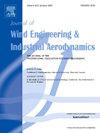Aerostatic stability analysis of a suspension bridge based on the stiffness matrix singularity criterion
IF 4.9
2区 工程技术
Q1 ENGINEERING, CIVIL
Journal of Wind Engineering and Industrial Aerodynamics
Pub Date : 2025-09-16
DOI:10.1016/j.jweia.2025.106238
引用次数: 0
Abstract
The risk of aerostatic instability of long-span bridges grows with their span length increase. The judgment criteria for the critical state of aerostatic stability vary across the studies, implying large errors and difficulty in revealing the instability mechanism. Addressing the above issue, this study proposes a new judgment criterion, implying that the structure's stiffness matrix should be singular, while the product of the eigenvector of zero eigenvalues and the load vector should not be zero. The proposed criterion is expected to locate the limit points of structural instability and shed more light on its essence, including the critical wind velocity and aerostatic stability mechanism. To this end, the detailed calculation process of the proposed method is presented. Its effectiveness and accuracy are verified by a case study of the Ma'anshan Yangtze River Bridge in China, featuring a suspension bridge with three towers. For the initial wind angles of attack at 0° and +3°, the overall stiffness matrix of the bridge was singular at the last loading step. The limit points of instability of the bridge were inferred based on the above criterion. The critical wind velocities for aerostatic stability were 122.7 and 120 m/s, respectively. However, the stiffness matrix was not singular at the −3°initial angle of attack.
基于刚度矩阵奇异准则的悬索桥静压稳定性分析
大跨径桥梁的静力失稳风险随着跨径的增大而增大。在不同的研究中,空气静力稳定临界状态的判断标准各不相同,这意味着误差较大,难以揭示不稳定机制。针对上述问题,本文提出了一种新的判断准则,即结构的刚度矩阵必须是奇异的,而零特征值的特征向量与荷载向量的乘积不应为零。该准则有望定位结构失稳的极限点,揭示结构失稳的本质,包括临界风速和静压稳定机理。为此,给出了该方法的详细计算过程。以马鞍山长江大桥三塔悬索桥为例,验证了该方法的有效性和准确性。在初始风攻角为0°和+3°时,最后加载阶段桥梁整体刚度矩阵为奇异。在此基础上,推导了桥梁的失稳极限点。空气静力稳定的临界风速分别为122.7和120 m/s。但在初始迎角为- 3°时,刚度矩阵并不奇异。
本文章由计算机程序翻译,如有差异,请以英文原文为准。
求助全文
约1分钟内获得全文
求助全文
来源期刊
CiteScore
8.90
自引率
22.90%
发文量
306
审稿时长
4.4 months
期刊介绍:
The objective of the journal is to provide a means for the publication and interchange of information, on an international basis, on all those aspects of wind engineering that are included in the activities of the International Association for Wind Engineering http://www.iawe.org/. These are: social and economic impact of wind effects; wind characteristics and structure, local wind environments, wind loads and structural response, diffusion, pollutant dispersion and matter transport, wind effects on building heat loss and ventilation, wind effects on transport systems, aerodynamic aspects of wind energy generation, and codification of wind effects.
Papers on these subjects describing full-scale measurements, wind-tunnel simulation studies, computational or theoretical methods are published, as well as papers dealing with the development of techniques and apparatus for wind engineering experiments.

 求助内容:
求助内容: 应助结果提醒方式:
应助结果提醒方式:


